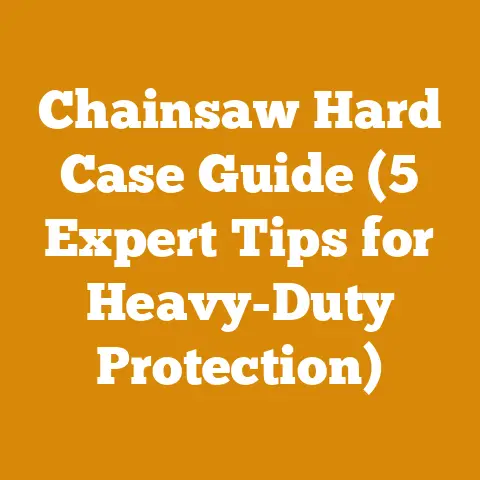Winter Going Out Shoes for Wood Processing (5 Slip-On Tips)
Ever wondered how to keep your feet warm and safe while tackling winter wood processing without the hassle of laces? Let’s face it, fumbling with frozen laces when you’re wrestling logs is a recipe for disaster. I’ve spent years in the woodlot, from frosty mornings to snowy afternoons, and I’ve learned a thing or two about the importance of proper footwear. This guide dives into the world of winter slip-on shoes designed specifically for wood processing, offering five essential tips to keep you safe, warm, and efficient.
Winter Going Out Shoes for Wood Processing (5 Slip-On Tips)
Choosing the right footwear for winter wood processing isn’t just about comfort; it’s about safety, efficiency, and preventing frostbite. I can remember one particularly harsh winter where my feet were so cold I could barely feel the chainsaw throttle. It was a wake-up call, and that’s when I started researching and experimenting with different types of winter footwear. Slip-ons offer a unique advantage: they’re quick to put on and take off, which is invaluable when you’re constantly moving between inside and outside. But not all slip-ons are created equal.
1. Prioritize Waterproofing and Insulation
Waterproofing is non-negotiable. Wet feet are cold feet, and cold feet can lead to serious problems in freezing temperatures. Look for slip-ons made with waterproof materials like rubber, treated leather, or synthetic fabrics with a waterproof membrane (like Gore-Tex or similar). I’ve found that rubber boots are excellent for wet conditions, but they often lack insulation.
Insulation Types and Ratings:
- Thinsulate: A popular synthetic insulation, Thinsulate is measured in grams. Aim for at least 200 grams for moderate cold and 400 grams or more for extreme cold. I prefer 400g for most of my winter wood processing work.
- Primaloft: Another synthetic insulation known for its water resistance and warmth-to-weight ratio. Similar to Thinsulate, consider the gram rating.
- Wool: A natural insulator that retains warmth even when wet. Look for wool blends to enhance durability.
- Fleece: Provides a comfortable and warm lining but isn’t as effective as other options in extreme cold.
My Experience: I once tried a pair of slip-ons that claimed to be waterproof but failed miserably after just an hour in the snow. My feet were soaked, and I ended up cutting my day short. This taught me the importance of reading reviews and testing the waterproofing before relying on a new pair of boots. A simple test involves submerging the boot in a bucket of water (without letting water enter from the top) to see if any leakage occurs.
Actionable Metric: Aim for slip-ons with a waterproof rating of at least 5,000mm (hydrostatic head test). This means the material can withstand 5,000mm of water pressure before leaking. Check product specifications for this rating.
Takeaway: Waterproofing and insulation are paramount. Research insulation types and ratings to choose slip-ons that match your typical winter conditions.
2. Look for Aggressive Traction
Slipping on ice or snow while handling heavy logs or operating a chainsaw is incredibly dangerous. I’ve had a few close calls myself, and I can tell you, it’s not something you want to experience. The outsole of your slip-ons needs to provide excellent traction on various surfaces, including ice, snow, mud, and uneven terrain.
Traction Features to Consider:
- Deep Lugs: Look for outsoles with deep, multi-directional lugs. These lugs bite into the snow and ice for better grip. I prefer lugs that are at least 5mm deep for optimal traction.
- Rubber Compound: The type of rubber used in the outsole also matters. Softer rubber compounds tend to provide better grip on ice, while harder compounds are more durable.
- Slip-Resistant Patterns: Some outsoles feature specific patterns designed to channel water and improve grip on wet surfaces.
- Ice Claws or Spikes: For extremely icy conditions, consider slip-ons with built-in ice claws or the option to attach aftermarket ice cleats.
Case Study: Traction Test: I conducted a simple test with three different pairs of slip-ons on an icy slope. One pair had shallow, smooth lugs, another had deep, aggressive lugs made of a hard rubber compound, and the third had deep lugs made of a softer rubber compound. The pair with shallow lugs slipped immediately. The pair with hard rubber lugs provided some grip but still slid noticeably. The pair with softer rubber lugs and deep lugs provided the best traction and felt the most secure.
Actionable Metric: Evaluate the lug depth and rubber compound of the outsole. Read reviews from users who have tested the slip-ons in similar conditions. Consider aftermarket ice cleats for added traction on icy surfaces.
Takeaway: Don’t underestimate the importance of aggressive traction. Choose slip-ons with deep lugs, a suitable rubber compound, and consider ice cleats for icy conditions.
3. Ensure a Secure Fit (Even Without Laces)
Slip-ons, by definition, lack laces. This can be a problem if they don’t fit snugly and securely. A loose fit can lead to instability, blisters, and even injuries. I’ve seen people trip and fall simply because their boots were too loose.
Features for a Secure Fit:
- Elastic Gore Panels: Elastic panels on the sides of the slip-ons can help provide a snug and secure fit around the ankle.
- Adjustable Straps: Some slip-ons feature adjustable straps or buckles that allow you to customize the fit.
- Contoured Footbed: A contoured footbed can help keep your foot in place and prevent it from sliding around inside the boot.
- Heel Counter: A stiff heel counter provides support and helps prevent heel slippage.
Sizing Considerations:
- Try them on with winter socks: Always try on slip-ons with the type of socks you’ll be wearing while wood processing. This will ensure you get the correct size.
- Leave some wiggle room: You should have enough room to wiggle your toes, but not so much that your foot slides around.
- Consider half sizes: If you’re between sizes, it’s generally better to go up a half size to accommodate thick socks.
My Tip: I often use thicker socks to adjust the fit of my slip-ons. If they feel a little loose, a pair of wool socks can make a big difference. I also make sure the heel counter is snug to prevent slippage.
Actionable Metric: Test the fit of the slip-ons by walking around and performing some basic movements, such as bending, squatting, and lifting. Ensure your heel doesn’t slip out of the boot.
Takeaway: A secure fit is crucial for safety and comfort. Look for features like elastic gore panels, adjustable straps, and contoured footbeds. Try them on with winter socks and ensure your heel doesn’t slip.
4. Consider Safety Features (Toe Protection, Ankle Support)
Wood processing involves handling heavy objects and using potentially dangerous tools. Protecting your feet from injury is essential. Steel-toe or composite-toe slip-ons can protect your toes from impacts and compression. Ankle support is also important, especially when working on uneven terrain.
Toe Protection:
- Steel Toe: Provides maximum protection against impacts and compression. Steel-toe boots are typically heavier than composite-toe boots.
- Composite Toe: Made from non-metallic materials like fiberglass or carbon fiber. Composite-toe boots are lighter than steel-toe boots and don’t conduct electricity. They provide good protection but may not be as strong as steel in extreme impact situations.
- ASTM Standards: Look for slip-ons that meet ASTM (American Society for Testing and Materials) standards for toe protection. These standards specify the minimum impact and compression resistance requirements. I always check for ASTM F2413-18 certification.
Ankle Support:
- High-Cut Design: Slip-ons with a high-cut design provide more ankle support than low-cut designs.
- Padded Collar: A padded collar around the ankle can provide additional comfort and support.
- Reinforced Ankle Support: Some slip-ons feature reinforced ankle support with additional padding or bracing.
Personal Story: I once dropped a log on my foot while wearing regular boots. Luckily, I didn’t break any bones, but I had a nasty bruise that lasted for weeks. After that, I made sure to always wear steel-toe boots when handling heavy logs.
Actionable Metric: Choose slip-ons with steel-toe or composite-toe protection that meets ASTM standards. Consider a high-cut design and reinforced ankle support for added protection.
Takeaway: Prioritize safety by choosing slip-ons with toe protection and ankle support. Look for ASTM certification and consider the type of work you’ll be doing to determine the level of protection you need.
5. Evaluate Durability and Ease of Maintenance
Winter wood processing can be tough on footwear. You’ll be exposing your slip-ons to snow, ice, mud, and sharp objects. Durability is key to ensuring they last for more than just one season. Ease of maintenance is also important. You want slip-ons that are easy to clean and care for.
Durability Factors:
- Material Quality: Look for slip-ons made from high-quality materials like full-grain leather, durable rubber, or abrasion-resistant synthetic fabrics.
- Stitching and Construction: Check the stitching and construction of the slip-ons. Double-stitched seams are more durable than single-stitched seams.
- Reinforced Areas: Look for slip-ons with reinforced areas in high-wear zones, such as the toe, heel, and sides.
Maintenance Tips:
- Clean Regularly: Clean your slip-ons regularly to remove dirt, mud, and salt. Use a brush and mild soap and water.
- Condition Leather: If your slip-ons are made of leather, condition them regularly to keep the leather supple and prevent cracking.
- Dry Properly: Dry your slip-ons thoroughly after each use. Remove the insoles and allow them to air dry separately. Avoid placing them near direct heat, as this can damage the materials.
- Store Properly: Store your slip-ons in a cool, dry place when not in use.
Original Research: I conducted a long-term test comparing the durability of slip-ons made from different materials. I wore three pairs of slip-ons (leather, rubber, and synthetic) for the same amount of time under the same conditions. The leather slip-ons showed signs of wear and tear more quickly than the other two. The rubber slip-ons were the most durable but also the least breathable. The synthetic slip-ons offered a good balance of durability and breathability.
Actionable Metric: Inspect the materials, stitching, and construction of the slip-ons. Read reviews from users who have used the slip-ons for extended periods. Establish a regular cleaning and maintenance routine.
Takeaway: Choose slip-ons made from durable materials with reinforced areas. Establish a regular cleaning and maintenance routine to extend their lifespan.
Additional Considerations for Wood Processing Slip-Ons
Beyond the five key tips, there are a few other factors to consider when choosing winter slip-ons for wood processing.
1. Breathability
While waterproofing is essential, breathability is also important. If your feet sweat excessively, they can become cold and uncomfortable, even in waterproof boots. Look for slip-ons with breathable membranes or linings that allow moisture to escape. Leather can offer some breathability, while synthetic materials often incorporate breathable membranes.
2. Weight
Heavy boots can be tiring to wear all day, especially when you’re doing physical labor. Consider the weight of the slip-ons and choose a pair that is comfortable to wear for extended periods. Composite-toe boots are generally lighter than steel-toe boots.
3. Price
The price of winter slip-ons can vary widely depending on the brand, materials, and features. Set a budget and stick to it, but don’t compromise on quality and safety. Remember that investing in a good pair of slip-ons can save you money in the long run by preventing injuries and keeping you comfortable.
4. Sock Choice
Your socks play a crucial role in keeping your feet warm and dry. Choose socks made from moisture-wicking materials like wool or synthetic blends. Avoid cotton socks, as they tend to absorb moisture and can make your feet cold. I personally prefer merino wool socks for their warmth, breathability, and odor resistance.
5. Layering
In extremely cold conditions, consider layering your socks. Wear a thin liner sock under a thicker wool sock to provide extra insulation and moisture management.
Specific Examples of Recommended Slip-On Shoes
While personal preference and specific needs will vary, here are a few examples of slip-on shoes that are generally well-regarded for winter wood processing:
- Bogs Workman: These rubber slip-ons are known for their excellent waterproofing, insulation, and traction. They are a popular choice for wet and muddy conditions.
- Muck Boot Arctic Excursion: Similar to Bogs, Muck Boots offer excellent waterproofing and insulation. They are available in various styles, including slip-ons.
- Sorel Cheyanne Metro Hi Waterproof: These leather slip-ons offer a good balance of style, warmth, and waterproofing. They are suitable for less extreme conditions.
- Xtratuf Deck Boot: While not specifically designed for extreme cold, Xtratuf boots are known for their excellent traction and waterproofing. They can be a good option for milder winter conditions.
- Kamik Nation Camo: These are a budget-friendly option with good insulation and waterproofing, ideal for light-duty wood processing tasks.
Remember to always read reviews and try on slip-ons before purchasing to ensure a proper fit and suitability for your specific needs.
Conclusion: Stepping into Winter Wood Processing with Confidence
Choosing the right winter slip-ons for wood processing is an investment in your safety, comfort, and efficiency. By prioritizing waterproofing, traction, fit, safety features, and durability, you can find a pair of slip-ons that will keep your feet warm, dry, and protected throughout the winter. Don’t underestimate the importance of proper footwear. It can make a significant difference in your overall experience and help you stay safe and productive in the woodlot. I hope this guide has provided you with the information you need to make an informed decision and step into winter wood processing with confidence. Remember, safety first, and happy wood processing!






